Efficient Exciplex-Based Deep-Blue Organic Light-Emitting Diodes Employing a Bis(4-fluorophenyl)amine-Substituted Heptazine Acceptor
Abstract
:1. Introduction
2. Results and Discussion
3. Materials and Methods
3.1. Synthesis of 2,5,8-Tris(di(4-fluorophenyl)amine)-1,3,4,6,7,9,9b-heptaazaphenalene (HAP-3FDPA)
3.2. OLED Fabrication and Measurement
4. Conclusions
Supplementary Materials
Author Contributions
Funding
Institutional Review Board Statement
Informed Consent Statement
Data Availability Statement
Conflicts of Interest
References
- Uoyama, H.; Goushi, K.; Shizu, K.; Nomura, H.; Adachi, C. Highly efficient organic light-emitting diodes from delayed fluorescence. Nature 2012, 492, 234–238. [Google Scholar] [CrossRef] [PubMed]
- Konidena, R.K.; Lee, J.Y. Molecular design tactics for highly efficient thermally activated delayed fluorescence emitters for organic light emitting diodes. Chem. Rec. 2019, 19, 1499–1517. [Google Scholar] [CrossRef] [PubMed]
- Cai, M.; Zhang, D.; Duan, L. High performance thermally activated delayed fluorescence sensitized organic light-emitting diodes. Chem. Rec. 2019, 19, 1611–1623. [Google Scholar] [CrossRef]
- Kim, J.U.; Park, I.S.; Chan, C.Y.; Tanaka, M.; Tsuchiya, Y.; Nakanotani, H.; Adachi, C. Nanosecond-time-scale delayed fluorescence molecule for deep-blue oleds with small efficiency rolloff. Nat. Commun. 2020, 11, 1765. [Google Scholar] [CrossRef] [Green Version]
- Peng, C.C.; Yang, S.Y.; Li, H.C.; Xie, G.H.; Cui, L.S.; Zou, S.N.; Poriel, C.; Jiang, Z.Q.; Liao, L.S. Highly efficient thermally activated delayed fluorescence via an unconjugated donor-acceptor system realizing eqe of over 30%. Adv. Mater. 2020, 32, 2003885. [Google Scholar] [CrossRef] [PubMed]
- Kim, M.; Jeon, S.K.; Hwang, S.H.; Lee, S.S.; Yu, E.; Lee, J.Y. Highly efficient and color tunable thermally activated delayed fluorescent emitters using a “twin emitter” molecular design. Chem. Commun. 2016, 52, 339–342. [Google Scholar] [CrossRef] [PubMed]
- Lundberg, P.; Lindh, E.M.; Tang, S.; Edman, L. Toward efficient and metal-free emissive devices: A solution processed host guest light-emitting electrochemical cell featuring thermally activated delayed fluorescence. ACS Appl. Mater. Inter. 2017, 9, 28810–28816. [Google Scholar] [CrossRef]
- Yin, X.; He, Y.; Wang, X.; Wu, Z.X.; Pang, E.B.; Xu, J.; Wang, J.A. Recent advances in thermally activated delayed fluorescent polymer-molecular designing strategies. Front. Chem. 2020, 8, 725. [Google Scholar] [CrossRef] [PubMed]
- Endo, A.; Sato, K.; Yoshimura, K.; Kai, T.; Kawada, A.; Miyazaki, H.; Adachi, C. Efficient up-conversion of triplet excitons into a singlet state and its application for organic light emitting diodes. Appl. Phys. Lett. 2011, 98, 083302. [Google Scholar] [CrossRef]
- Zhang, Q.S.; Li, B.; Huang, S.P.; Nomura, H.; Tanaka, H.; Adachi, C. Efficient blue organic light-emitting diodes employing thermally activated delayed fluorescence. Nat. Photonics 2014, 8, 326–332. [Google Scholar] [CrossRef]
- Cai, X.Y.; Li, X.L.; Xie, G.Z.; He, Z.Z.; Gao, K.; Liu, K.K.; Chen, D.C.; Cao, Y.; Su, S.J. “Rate-limited effect” of reverse intersystem crossing process: The key for tuning thermally activated delayed fluorescence lifetime and efficiency roll-off of organic light emitting diodes. Chem. Sci. 2016, 7, 4264–4275. [Google Scholar] [CrossRef] [Green Version]
- Wong, M.Y.; Zysman-Colman, E. Purely organic thermally activated delayed fluorescence materials for organic light-emitting diodes. Adv. Mater. 2017, 29, 54. [Google Scholar] [CrossRef] [Green Version]
- Kothavale, S.; Chung, W.J.; Lee, J.Y. High efficiency and long lifetime orange-red thermally activated delayed fluorescent organic light emitting diodes by donor and acceptor engineering. J. Mater. Chem. C 2021, 9, 528–536. [Google Scholar] [CrossRef]
- Li, J.; Zhang, Q.S.; Nomura, H.; Miyazaki, H.; Adachi, C. Thermally activated delayed fluorescence from 3nπ* to 1nπ* up-conversion and its application to organic light-emitting diodes. Appl. Phys. Lett. 2014, 105, 013301. [Google Scholar] [CrossRef]
- Li, J.; Gong, H.; Zhang, J.; Zhou, S.; Tao, L.; Jiang, L.; Guo, Q. Enhanced electroluminescence based on a pi-conjugated heptazine derivative by exploiting thermally activated delayed fluorescence. Front. Chem. 2021, 9, 693813. [Google Scholar] [CrossRef]
- Goushi, K.; Yoshida, K.; Sato, K.; Adachi, C. Organic light-emitting diodes employing efficient reverse intersystem crossing for triplet-to-singlet state conversion. Nat. Photonics 2012, 6, 253–258. [Google Scholar] [CrossRef]
- Li, J.; Nomura, H.; Miyazaki, H.; Adachi, C. Highly efficient exciplex organic light-emitting diodes incorporating a heptazine derivative as an electron acceptor. Chem. Commun. 2014, 50, 6174–6176. [Google Scholar] [CrossRef] [PubMed]
- Graves, D.; Jankus, V.; Dias, F.B.; Monkman, A. Photophysical investigation of the thermally activated delayed emission from films of m-mtdata: Pbd exciplex. Adv. Funct. Mater. 2014, 24, 2343–2351. [Google Scholar] [CrossRef]
- Liu, X.K.; Chen, Z.; Zheng, C.J.; Liu, C.L.; Lee, C.S.; Li, F.; Ou, X.M.; Zhang, X.H. Prediction and design of efficient exciplex emitters for high-efficiency, thermally activated delayed-fluorescence organic light-emitting diodes. Adv. Mater. 2015, 27, 2378–2383. [Google Scholar] [CrossRef]
- Zhang, M.; Zheng, C.J.; Lin, H.; Tao, S.L. Thermally activated delayed fluorescence exciplex emitters for high-performance organic light-emitting diodes. Mater. Horiz. 2021, 8, 401–425. [Google Scholar] [CrossRef]
- Wang, Q.; Ding, J.Q.; Ma, D.G.; Cheng, Y.X.; Wang, L.X.; Jing, X.B.; Wang, F.S. Harvesting excitons via two parallel channels for efficient white organic leds with nearly 100% internal quantum efficiency: Fabrication and emission-mechanism analysis. Adv. Funct. Mater. 2009, 19, 84–95. [Google Scholar] [CrossRef]
- Li, J.; Nakagawa, T.; MacDonald, J.; Zhang, Q.; Nomura, H.; Miyazaki, H.; Adachi, C. Highly efficient organic light-emitting diode based on a hidden thermally activated delayed fluorescence channel in a heptazine derivative. Adv. Mater. 2013, 25, 3319–3323. [Google Scholar] [CrossRef]
- Kumar, S.; Sharma, N.; Kailasam, K. Emergence of s-heptazines: From trichloro-s-heptazine building blocks to functional materials. J. Mater. Chem. A 2018, 6, 21719–21728. [Google Scholar] [CrossRef]
- Audebert, P.; Kroke, E.; Posern, C.; Lee, S.H. State of the art in the preparation and properties of molecular monomeric s-heptazines: Syntheses, characteristics, and functional applications. Chem. Rev. 2021, 121, 2515–2544. [Google Scholar] [CrossRef]
- Li, J.; Zhang, J.; Gong, H.; Tao, L.; Wang, Y.; Guo, Q. Efficient deep-blue electroluminescence employing heptazine-based thermally activated delayed fluorescence. Photonics 2021, 8, 293. [Google Scholar] [CrossRef]
- Li, J.; Tao, L.; Wang, Y.; Yao, Y.; Guo, Q. Heptazine-based π-conjugated materials for light-emitting. Front. Chem. 2021, 9, 717569. [Google Scholar] [CrossRef]
- Hung, W.Y.; Fang, G.C.; Chang, Y.C.; Kuo, T.Y.; Chou, P.T.; Lin, S.W.; Wong, K.T. Highly efficient bilayer interface exciplex for yellow organic light-emitting diode. ACS Appl. Mater. Interfaces 2013, 5, 6826–6831. [Google Scholar] [CrossRef] [PubMed]
- Lin, T.; Zhang, T.Y.; Song, Q.G.; Jin, F.M.; Liu, Z.Q.; Su, Z.S.; Luo, Y.S.; Chu, B.; Lee, C.S.; Li, W.L. Thermally activated delayed-fluorescence organic light-emitting diodes based on exciplex emitter with high efficiency and low roll-off. Org. Electron. 2016, 38, 69–73. [Google Scholar] [CrossRef]
- Yuan, S.L.; Du, X.Y.; Zhao, J.W.; Liu, W.; Lin, H.; Zheng, C.J.; Tao, S.L.; Zhang, X.H. High-performance red organic light-emitting devices based on an exciplex system with thermally activated delayed fluorescence characteristic. Org. Electron. 2016, 39, 10–15. [Google Scholar] [CrossRef]
- Santos, P.L.; Dias, F.B.; Monkman, A.P. Investigation of the mechanisms giving rise to tadf in exciplex states. J. Phys. Chem. C 2016, 120, 18259–18267. [Google Scholar] [CrossRef] [Green Version]
- Liu, W.; Chen, J.X.; Zheng, C.J.; Wang, K.; Chen, D.Y.; Li, F.; Dong, Y.P.; Lee, C.S.; Ou, X.M.; Zhang, X.H. Novel strategy to develop exciplex emitters for high-performance oleds by employing thermally activated delayed fluorescence materials. Adv. Funct. Mater. 2016, 26, 2002–2008. [Google Scholar] [CrossRef]
- Wu, T.L.; Liao, S.Y.; Huang, P.Y.; Hong, Z.S.; Huang, M.P.; Lin, C.C.; Cheng, M.J.; Cheng, C.H. Exciplex organic light-emitting diodes with nearly 20% external quantum efficiency: Effect of intermolecular steric hindrance between the donor and acceptor pair. ACS Appl. Mater. Interfaces 2019, 11, 19294–19300. [Google Scholar] [CrossRef] [PubMed]
- Shirota, Y.; Kageyama, H. Charge carrier transporting molecular materials and their applications in devices. Chem. Rev. 2007, 107, 953–1010. [Google Scholar] [CrossRef] [PubMed]
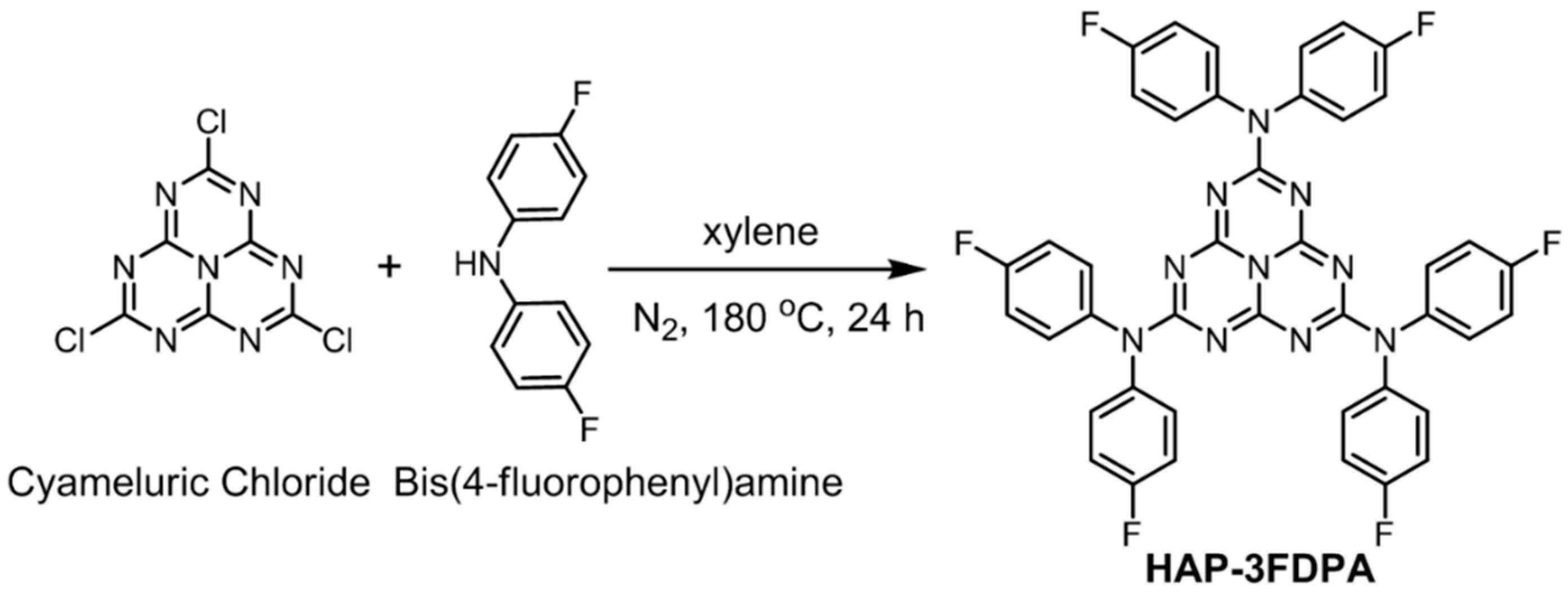

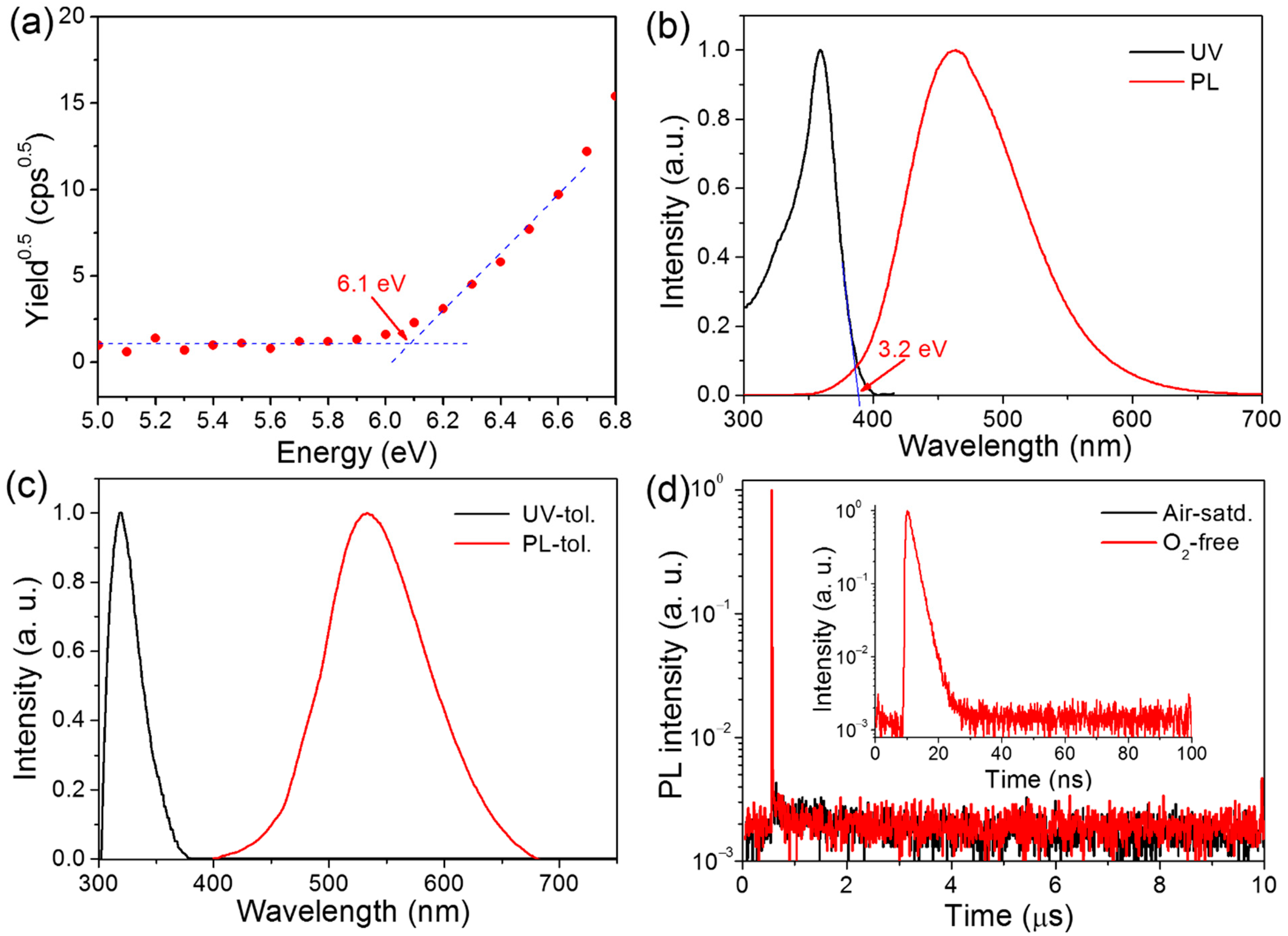
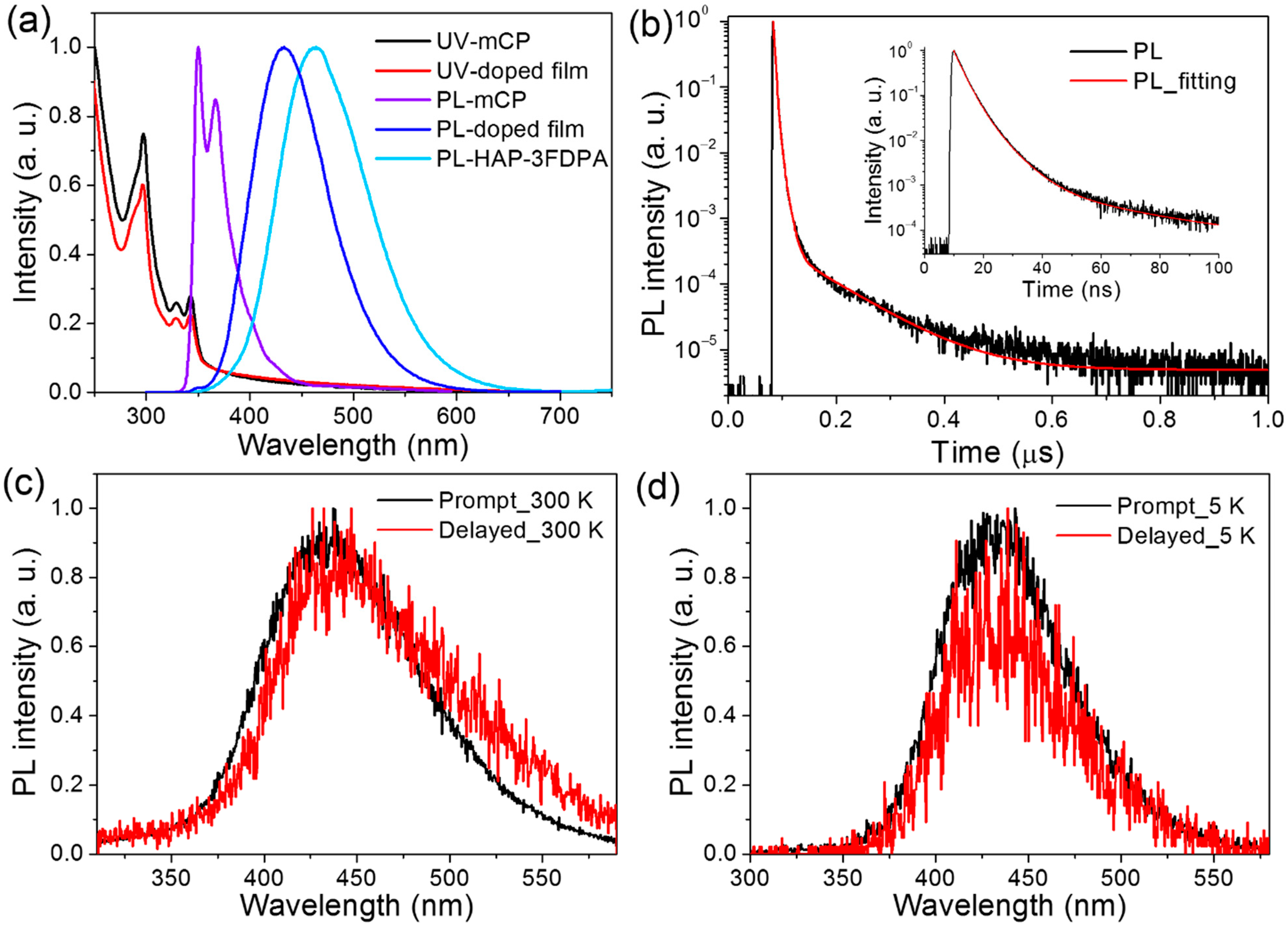
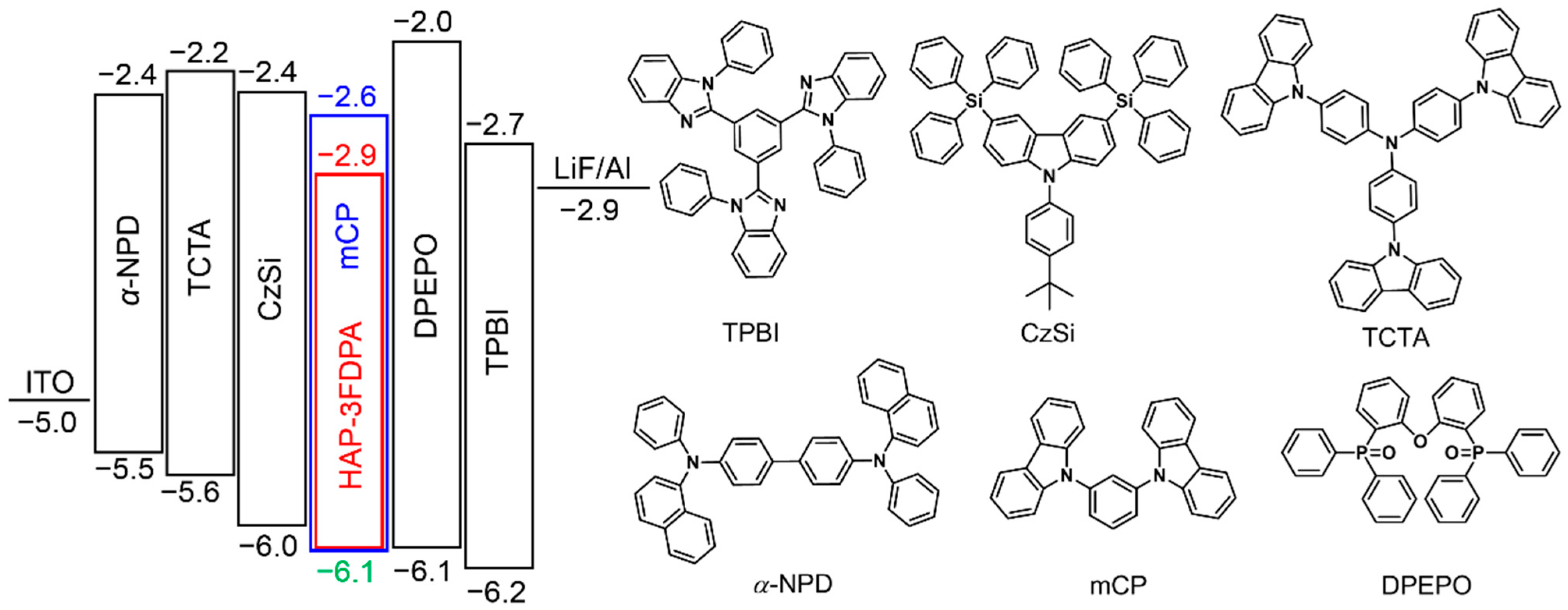
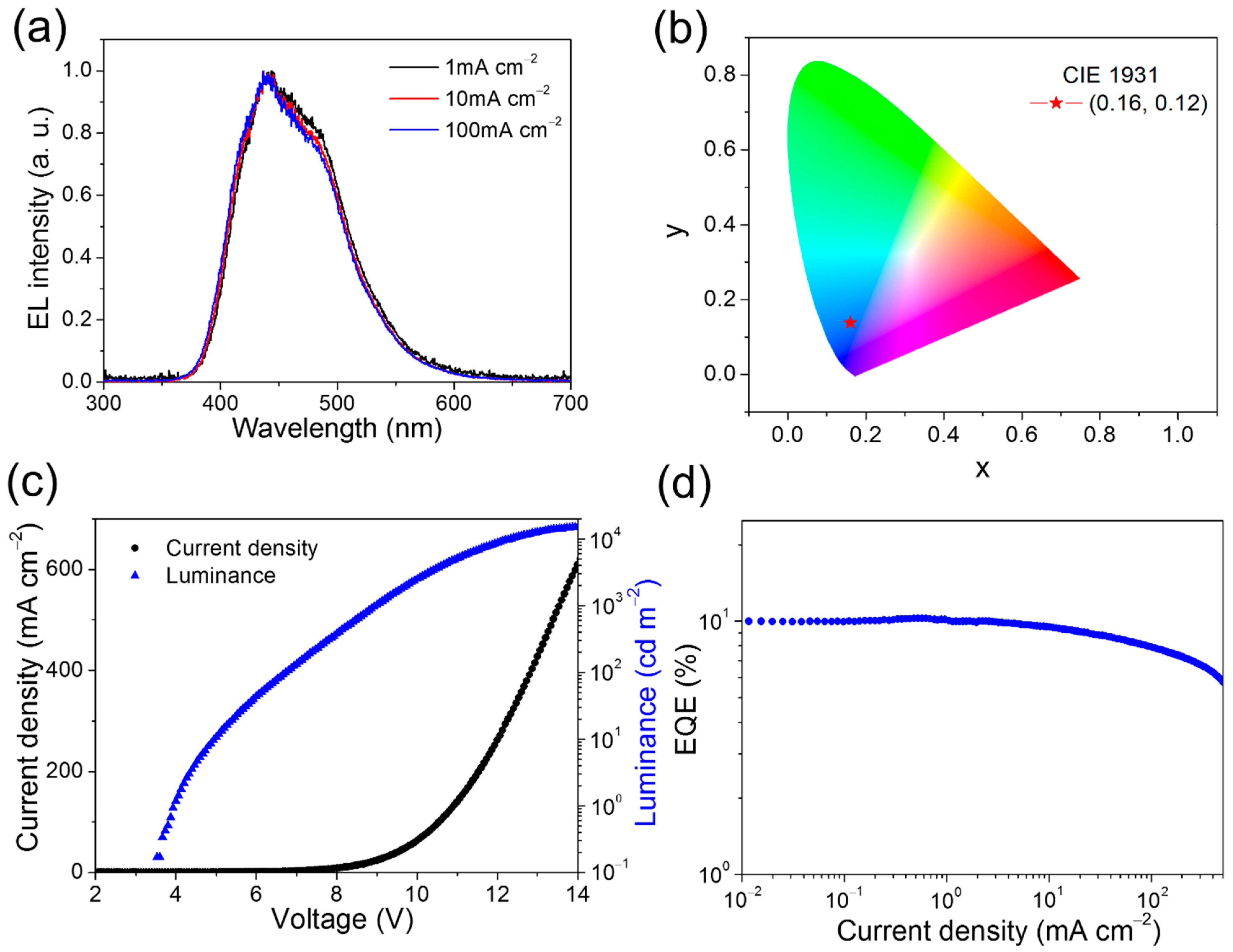
| Compound | HOMO/LUMO (eV) | λabs (nm) | λem (nm) | τp (ns) | τd (ns) | PLQY | FWHM (nm) |
|---|---|---|---|---|---|---|---|
| HAP-3FDPA | −6.1/−2.9 | 359 a/319 b | 464 a/533 b | 1.9 b | - | 5.1% b | 101 a/102 b |
| Doped film | - | 342 | 433 | 3.0 | 8.0, 86.1 | 53.2% | 87 |
| Emitter | Von (V) a | λEL (nm) | Lmax (cd m−2) | EQE (%) b | CIE (x, y) |
|---|---|---|---|---|---|
| 8 wt% HAP-3FDPA:mCP | 4.0 | 437 | 15,148 | 10.2/10.0/9.0/7.7/6.7 | 0.16, 0.12 |
Publisher’s Note: MDPI stays neutral with regard to jurisdictional claims in published maps and institutional affiliations. |
© 2021 by the authors. Licensee MDPI, Basel, Switzerland. This article is an open access article distributed under the terms and conditions of the Creative Commons Attribution (CC BY) license (https://creativecommons.org/licenses/by/4.0/).
Share and Cite
Li, J.; Gong, H.; Zhang, J.; Liu, H.; Tao, L.; Wang, Y.; Guo, Q. Efficient Exciplex-Based Deep-Blue Organic Light-Emitting Diodes Employing a Bis(4-fluorophenyl)amine-Substituted Heptazine Acceptor. Molecules 2021, 26, 5568. https://doi.org/10.3390/molecules26185568
Li J, Gong H, Zhang J, Liu H, Tao L, Wang Y, Guo Q. Efficient Exciplex-Based Deep-Blue Organic Light-Emitting Diodes Employing a Bis(4-fluorophenyl)amine-Substituted Heptazine Acceptor. Molecules. 2021; 26(18):5568. https://doi.org/10.3390/molecules26185568
Chicago/Turabian StyleLi, Jie, Heqi Gong, Jincheng Zhang, Hui Liu, Li Tao, Yanqing Wang, and Qiang Guo. 2021. "Efficient Exciplex-Based Deep-Blue Organic Light-Emitting Diodes Employing a Bis(4-fluorophenyl)amine-Substituted Heptazine Acceptor" Molecules 26, no. 18: 5568. https://doi.org/10.3390/molecules26185568
APA StyleLi, J., Gong, H., Zhang, J., Liu, H., Tao, L., Wang, Y., & Guo, Q. (2021). Efficient Exciplex-Based Deep-Blue Organic Light-Emitting Diodes Employing a Bis(4-fluorophenyl)amine-Substituted Heptazine Acceptor. Molecules, 26(18), 5568. https://doi.org/10.3390/molecules26185568






